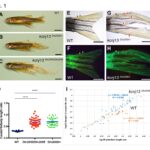Dr. Greg Golling Co-Authors Forthcoming Paper on Determining Fin Patterning in Zebrafish
Below is an Abstract of the scientific paper titled: “Potassium Channel-Associated Bioelectricity of the Dermomyotome Determines Fin Patterning in Zebrafish,” co-authored by Dr. Greg Golling, Taft College Professor of Life Science and soon-to-be-published in the August issue of the journal Genetics.
It has long been recognized that the morphological complexity of vertebrates is established by spatially and temporally regulated cell signaling. For decades, studies of the molecular mechanisms of body patterning have focused on conserved signaling molecules and transcription factors, which has led to major insights into how the embryo is patterned. However, the roles of bioelectric signaling in developmental patterning remain largely unknown. In this paper, we identify a potassium channel-based bioelectric signaling mechanism that regulates fin size in zebrafish. In addition, we provide the first evidence that fin size is determined by dermomyotome bioelectric properties.
Dr. Golling shared, “The start of the project relied on some technology I had helped to develop. I cultured a virus that was then used to infect zebrafish embryos. The virus would integrate into the genome of the fish. When the fish were older, they were bred to one another and the offspring were examined for obvious mutations. These fish developed long, flowing fins that were more characteristic of what you see with beta fish. I cloned the gene and found it was an inwardly rectifying potassium channel. My collaborators then did an enormous amount of work to show exactly how this gene product functions in the developing fish.”
Attached is one of the figures from the paper showing the normal fish (wt) and the mutant (kcnj13).
Congratulations Dr. Golling! We can’t wait to share the journal update in August!
